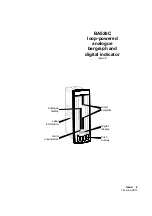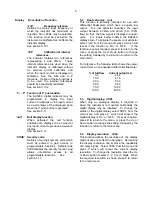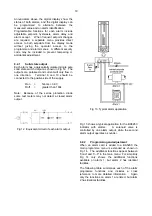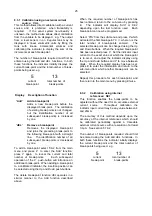
10
5.9
Calibration using internal references:
SEt
This function enables the zero and span of the
digital indicator to be adjusted without the need for
an accurate external current source, or for
disconnection from the 4/20mA loop.
The accuracy of this method depends upon the
accuracy of the internal references which should be
regularly calibrated as described in section 5.10.2
The analogue bargraph is automatically calibrated
when the digital display is calibrated, no separate
adjustments are required.
Fig 7 shows the
analogue display resulting from various digital
display calibrations.
To calibrate the indicator select 'SEt' from the main
menu and press
P.
The indicator will display 'ZErO',
pressing
P
again will reveal the current display at
4mA.
Each digit, except the dummy zero if
activated, of the indicator display can be changed by
pressing the
Up
or
Down
buttons. When the first
digit is correct pressing
P
will transfer control to the
next digit. When the least significant digit has been
adjusted, press
E
to return to the 'ZErO' prompt
which completes the adjustment.
To adjust the display at 20mA, press the
Up
button
which will cause the indicator to display 'SPAn'.
pressing
P
again will reveal the indicator display.
Each digit of the display, except the dummy zero
when activated, can be changed by pressing the
Up
or
Down
buttons. When the first digit is correct,
pressing
P
will transfer control to the next digit.
When the least significant digit has been adjusted
press
E t
o return to the 'SPAn' prompt followed by
E
to return to the menu.
5.10
Conditioning sub-menu: Cond
This is a password protected sub-menu which
allows the mains (line) frequency at which the
indicator has maximum ac rejection to be selected,
and the two internal references to be calibrated.
To gain access to the sub-menu select 'Cond' from
the main menu and press
P
. The indicator will
display '0000'. Using the
Up
and
Down
buttons and
the
P
button to move to the next digit
enter the password 'SurE'. (Note that 'S' is entered
as '5'). Pressing
E
will then give access to the two
functions in the sub-menu.
5.10.1
AC rejection: FrE
CAUTION
If the mains filter frequency is
changed, the indicator display and
internal references (if used) must be
recalibrated.
To provide maximum low frequency rejection the
internal digital filter may be set to operate at 50 or
60Hz to correspond with the local mains (line)
frequency.
To change the frequency select 'FrE'
from the 'Cond' sub-menu and press
P
which will
reveal the current setting.
The setting can be
toggled between the two options by pressing the
Up
or
Down
buttons. When set as required press
the
E
button to return to the sub-menu.
5.10.2
Calibration of internal references:
rEF
CAUTION
Do not attempt to recalibrate these
references unless you have adequate
test equipment and have read the
following instructions.
The indicator contains two references representing
4 and 20mA. These references are used in the
'SEt' function which enables the indicator displays
to be calibrated without an external current
calibrator.
They are also used in the 'C--P'
function if the instrument is programmed to display
the input current when the
P
push-button is
operated.
If the 'SEt' or 'C--P' functions are not
used, it is not necessary to calibrate these
internal references.
To calibrate the references connect the instrument
to an accurate 4/20mA current source and select
'rEF' from the sub-menu . Press
P
which will result
in a '.004A' prompt being displayed. Adjust the
external current calibrator to 4.000mA and again
press
P
. The indicator will display 'Ent' when the
4mA reference has been updated and will then
return to the '.004A' prompt.
To re-calibrate the 20mA internal reference, press
the
Up
button which will cause the
Summary of Contents for BA526C
Page 11: ...11 ...











































